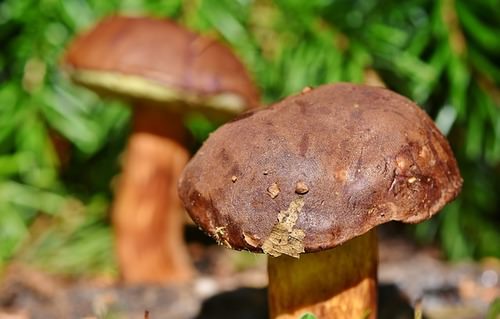菌菌结构结构 - 高级
章节大纲
-
Is the structure important?
::结构重要吗?Of course. Though mushrooms may be the most common type of , fungi also include rusts, smuts, puffballs, truffles, morels, molds, and yeasts, as well as many less well-known organisms . And, except for yeast , they all have similar structures, which are usually hidden deep within their food source. The part of the fungus that is seen, such as this part of the mushroom, is only a small part of the whole organism. And it is the part that contains the reproductive structures.
::当然,虽然蘑菇可能是最常见的类型,但真菌也包括生锈、泥土、泡泡、松露、软露、多菌、霉菌和酵母,以及许多不为人所知的有机体。除了酵母外,它们都有类似的结构,通常隐藏在食物源的深处。所看到的真菌的一部分,如蘑菇的这一部分,只是整个有机体的一小部分。它包含生殖结构的部分。Structure and Function in Fungi
::成真时的结构和功能Most fungi grow as thread-like filaments, while others such as yeasts, grow as single cells. Long, branching, filamentous fungal growths are called hyphae (singular, hypha ). A hypha consists of one or more cells that are surrounded by a tube-shaped, chitin-containing cell wall , as shown in Figure . Chitin-containing cell walls distinguish fungi from plants; walls contain cellulose .
::大部分真菌生长为线状丝,而其他如酵母等的丝状丝生长为单细胞。长的、分支的、丝状的、丝状的真菌生长被称为hyphae(单质的、hypha的)。如图所示,Hypha由一个或多个细胞组成,这些细胞环绕着一个管状的、含有 Chitin 的细胞墙,如图所示。含有Chitin 的细胞墙将真菌和植物区分开来;墙上含有纤维素。The hyphae of most fungi are divided into cells by internal walls called septa (singular, septum ). Septa usually have little pores that are large enough to allow , , and sometimes to flow among cells. Hyphae that are divided into cells are called septate hyphae . However, the hyphae of some fungi are not separated by septa. Hyphae without septae are called coenocytic hyphae . Coenocytic hyphae are big, multinucleated cells.
::大部分真菌的脊椎被称为塞普塔( septa, septum)的内墙分为细胞。 塞帕通常只有很小的孔孔,足以允许,有时甚至可以跨细胞流动。 被划分为细胞的脑膜被称作静脉注射, 然而,一些真菌的脊椎并没有被塞普塔分离。 没有西普塔的脑膜被称作神经合金合金。 脑细胞是大而多核的细胞。Hyphae of a Penicillium mold. These hyphae are divided by septae and are called septate hyphae. The little “trees” are specialized hyphae on which spores are produced. The body of the fungus is made of a mass of branching hyphae and is called a mycelium (plural, mycelia ). Mycelia form the sexual structures of the fungus, with many , such as mushrooms, forming fruiting bodies. A mycelium may be tiny, forming a colony that is too small to see, or it may be very large. The mycelium of the honey fungus ( Armillaria ) may be one of the largest and oldest living organisms on Earth. The mycelium of a single fungus (of the species Armillaria ostoyae ) covers about 8.9 square kilometers (3.4 square miles) of the Malheur National Forest in the Blue Mountains in eastern Oregon. The fungus is estimated to be 2,400 years old.
::菌体的体积是由一大批支流合金组成的,叫做(花类,神秘),它构成真菌的性结构,许多如蘑菇,形成果质体。菌体可能很小,形成一个太小而看不见的聚居区,或者可能很大。蜂蜜真菌(阿米利亚)的可能是地球上最大和最古老的活生物体之一。(阿米利亚奥斯托亚亚物种的)一种单一真菌(阿米利亚奥斯托亚物种)的,覆盖俄勒冈东部蓝山马约尔国家森林的约8.9平方公里(3.4平方英里),这些真菌估计有2 400年的历史。Honey fungus, a member of the genus Armillaria. The mycelium of the fungus spreads out much farther than the fruiting bodies you see here. A large mycelium, dubbed the “Humungous Fungus” by the media, was found to cover about 8.9 square kilometers in an Oregon forest. Fruiting Bodies
::果实机构Some fungi become noticeable only when producing spores (fruiting), either as mushrooms or molds. For example, you can see the fruiting bodies of the Armillaria fungus in Figure , but the large “body” of the fungus, the mycelia, is hidden underground.
::有些真菌只有在生产蘑菇或霉菌时才会显露出来。 比如,你可以在图中看到Armillaria真菌的果实,但真菌的大“体”即迷宫,却隐藏在地下。In fungi, the sporocarp (also known as the fruiting body) is a multicellular structure on which spore producing structures form. The fruiting body is part of the sexual phase of a fungal ; the rest of the life cycle is characterized by the growth of mycelia.
::在真菌中,spororocarp(又称“果实体”)是一种多细胞结构,其产卵结构形成。 果实体是真菌性阶段的一部分。 后半生的特点是神秘的生长。Dimorphic Fungi
::变形真菌Some fungi take on different shapes, depending on their environmental conditions. These fungi are called dimorphic, because they have “two forms.” For example, the fungus Histoplasma capsulatum , which causes the disease histoplasmosis, is thermally dimorphic; it has two forms that are dependent on temperature. In temperatures of about 25°C, it grows as a brownish mycelium and looks like a mass of threads. At body temperature (37°C in humans), it grows as single, round yeast cells.
::有些真菌依其环境条件而具有不同的形状。这些真菌被称为突变型,因为它们有“两种形态 ” 。 比如,导致这种疾病的Histoplasma 扇形板的真菌是热性突变型的;它有两种形态,取决于温度。在大约25°C的温度下,它长成棕色的菌类,长得像一根线条。在身体温度(人体37°C)下,它长成单状圆形细胞。Watch the first 6 minutes of the video below to learn more about the structure of Fungi:
::观看以下影片头6分钟, 以了解更多关于真菌结构的讯息:Summary
::摘要-
In most fungi, hyphae are divided into septa; these fungi have septate hyphae. The hyphae of some fungi are not separated by septa and are called coenocytic hyphae. Coenocytic hyphae are multinucleated cells.
::在大多数真菌中,希伯来人被划分为塞普塔人;这些真菌曾静静地治疗希伯来人;有些真菌的希伯来人没有被塞普塔人分离开来,被称作共生体性希伯来人;科能性希伯利亚人是多核细胞。 -
The bodies of fungi are made of a mass of branching hyphae and are called mycelia.
::真菌的身体是由大量 分泌的脑膜组成 叫做迷宫 -
Often the body of fungi is not noticed until it forms a fruiting body.
::在真菌形成果实之前,通常不会注意到真菌的身体。 -
Some fungi take on different shapes, depending on their environmental conditions.
::有些真菌依其环境条件而具有不同的形状。
Review
::回顾-
Distinguish between septate and coenocytic hyphae.
::区分静脉冲和遗传细胞性脑膜。 -
Relate the structures of hyphae, mycelia, and fruiting bodies to one another.
::将海绵、迷宫和果实体的结构互相联系起来。 -
What does it mean if a fungus is dimorphic?
::如果真菌是畸形的,那是什么意思?
-
In most fungi, hyphae are divided into septa; these fungi have septate hyphae. The hyphae of some fungi are not separated by septa and are called coenocytic hyphae. Coenocytic hyphae are multinucleated cells.


